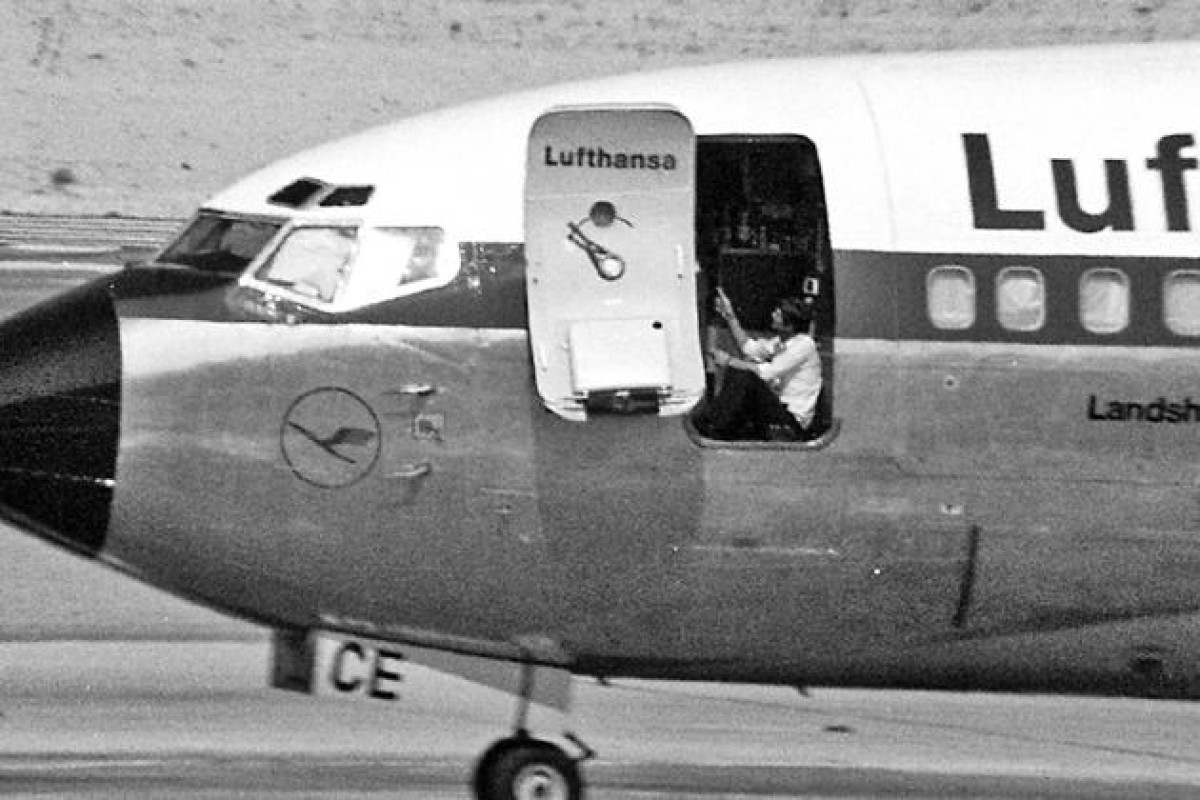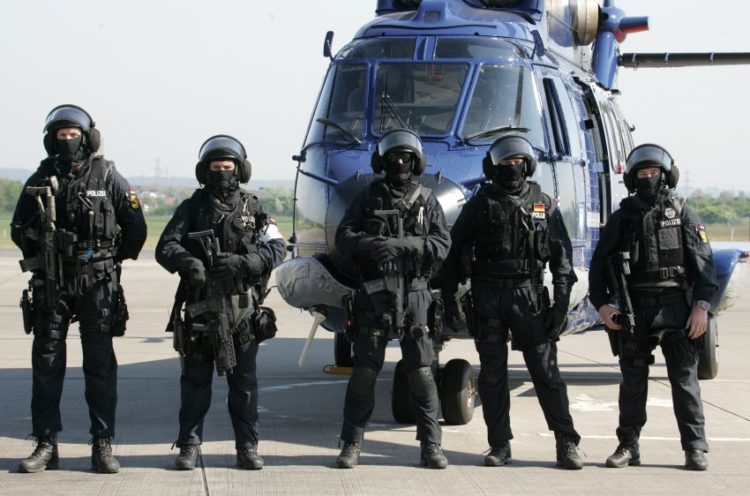Thursday, October 13, 1977, began as just another routine trip for the crew of Lufthansa Flight 181, as the Boeing 737 departed the island of Palma de Mallorca bound for Frankfurt Germany. Onboard, 86 passengers and five crew members went about their business, while the coast of mainland Europe slipped by below them. Little did they know that it would take an ordeal to eventually reach their destination.
Some 30 minutes into the flight, two men and two women wearing Che Guevera T-shirts rose from their seats brandishing pistols and hand grenades, while shouting commands to the passengers. They called themselves Commando Martyr Halime. Their leader, a Palestinian with the alias ‘Martyr Mahmud‘, forced his way into the cockpit and ordered the co-pilot to join the passengers.
Jurgen Schumann, the pilot, listened as Mahmud told him to set course for Cyprus. Schumann countered saying they didn’t have enough fuel and would have to land in Rome first.
Siegfried Hausner Commando, a faction of the German pro-communist terrorist organization known as the Red Army Faction, had allied themselves with the hijackers and demanded the release of 10 RAF compatriots from a German prison, along with two Palestinians held in Turkey. In addition, they wanted 15 million dollars in exchange for the lives of the passengers. Germany began negotiations, and at 5:45 p.m., the jet lifted off from Rome without clearance and headed for Cyprus.
On the ground in Cyprus, a representative from the Palestine Liberation Organization (PLO) arrived and attempted to negotiate the hostages’ release. Mahmud yelled at him over the radio and the man eventually gave up. At 10:50 p.m., the aircraft departed Cyprus and found itself being denied landing rights in Beirut, Baghdad, Damascus, and Kuwait. The only remaining airport was Bahrain, which they received word was closed. Schumann informed them they had to land again because of low fuel. A flight controller relented and they touched down at 1:52 a.m., only to have troops surround them, then withdraw after Mahmud held a gun to the co-pilot’s head and threatened to kill him. They refueled and left Bahrain, this time for Dubai.
Dubai ordered the runways blocked with vehicles, but as the plane made a low pass, Schumann pleaded with them to let them land as they once again were at their fuel limit. The vehicles, at last, raced away and they touched down in the morning light.
The terrorists ordered food and water to be brought in and the garbage to be removed. Seizing on the opportunity, Schumann proceeded to throw cigarette stubs out the hatch which informed the Germans on-site as to the number of terrorists. The information made its way to the Dubai authorities, who in turn gave an interview to journalists. The terrorists found out about it and Mahmud threatened to kill Schumann if refueling didn’t begin. What the terrorists didn’t know is that the Germans belonged to a unit that had arrived in Dubai shortly after Flight 181’s landing. The unit was led by a 48-year-old Oberleutnant( Lieutenant Colonel) named Ulrich Wegener, the man who had founded and commanded Grenshutzgruppe 9 (Border Guard Group 9), better known as GSG-9, Germany’s police counter-terrorism unit.
GSG-9 was created after the German police’s bungling of the 1972 Munich Olympics, in which Palestinian terrorists slaughtered Israeli hostages on a runway tarmac while being engaged by ill-trained sharpshooters. Determined not to repeat the past, Germany decreed the creation of a police counter-terrorism unit; soon thereafter on April 17, 1973, GSG-9 was born.
In Dubai, the unit was accompanied by two British Army Special Air Service (SAS) members, Barry Davies and Alistair Morrison. There, they received permission to assault the plane and even practiced on a 737 a short distance from flight 181. However, to their surprise, the Dubai government later permitted the flight to depart, and the jet traveled to Yemen where the worst fears became a reality. Mahmud permitted Schuman to check the plane over on the tarmac. The pilot left and attempted to contact the Yemeni authorities who sent him back, only to be executed by Mahmud in front of the passengers. Ordered to take off, the co-pilot was told to head for Mogadishu, Somalia.
After the arrival in Mogadishu, Schumann’s body was thrown on the tarmac. The captors bound the hostages and sprinkled Schnapps wine spirits over them saying that they would ‘burn better’ once they blew up the plane the next day. At 4:00 p.m., negotiators reestablished contact, notifying the terrorists that the prisoners would be released but that they needed more time. The deadline was extended to 2:30 a.m., October 18th.

It had been four days since the hijacking. The Germans decided that it must end. Operation Fire Magic, the assault plan formulated with the help of the two SAS, was again underway. Soon, as night fell, a blacked-out Boeing 707 touched down and taxied toward the rear of the Lufthansa plane.
Wegener and his 29 men along with Davies and Morrison, all dressed in casual attire, checked their weapons: MP5 submachine guns with mounted flashlights, and pistols. They crept both underneath the rear and to the left side of the plane carrying ladders. A rear hatch opened near the tail and operators entered, ready to shut off the power.
Suddenly a huge explosion boiled up a hundred yards in front of the plane. The Somalis had started a fire to distract the terrorists. After a few seconds passed the signal was given to cut the power.
“I threw a stun grenade over the wing and another over the cockpit,” Davies recounted.
Brilliant flashes thundered over the plane.
“Go! Go! Go!” came the shout.
Men sprang up the ladders jettisoning the twin hatches and swarmed for entry. Lights flashed on one of the female hijackers at the back and a quick burst jolted her body to the deck. The team rushed over her yelling “Heads Down!” Lights crisscrossed the aisle freezing on a male terrorist a few meters ahead.
“The number 3 terrorist was coming down the aisle with two hand grenades in his hand,” Wegner said.
His body was torn by 9mm rounds and the two grenades detonated in a dull explosion.
“One of the [s]tewardesses was slightly wounded, and that was it,” he added.
The Germans then moved toward the cockpit. Mahmud threw open the door and fired a pistol. An MP5’s muzzle flashed, and he slumped to the ground. They motioned for the passengers to exit the plane and they fled through every opening they could to the safety of the tarmac. The last passenger was out when the team found the fourth hijacker coming out a closet and shot her.
The assault lasted only five minutes. Apart from Schumann’s death, no other hostages died during the hijack, and as a result of the assault, only one hostage was wounded. Three of the four terrorists were killed, with one of the female hijackers surviving her wounds. One German team member was slightly wounded.
Since that fateful night of October 17, 1977, Operation Fire Magic has been studied time and again by the world’s counter-terrorism units as a textbook takedown of a hijacked airliner.
GSG-9 continues to covertly participate in missions the world over.
This article was previously published by SOFREP and Mike Perry 03.08.2012










COMMENTS
You must become a subscriber or login to view or post comments on this article.